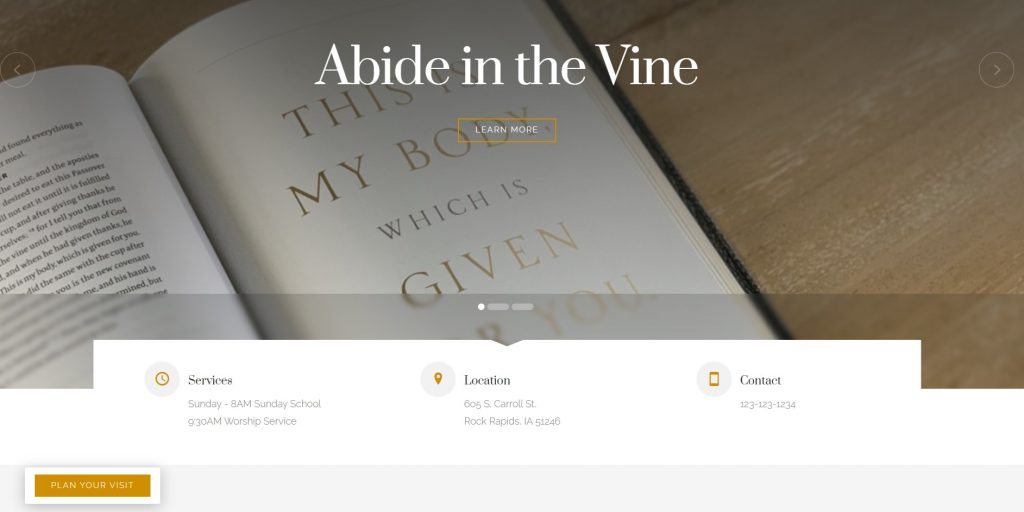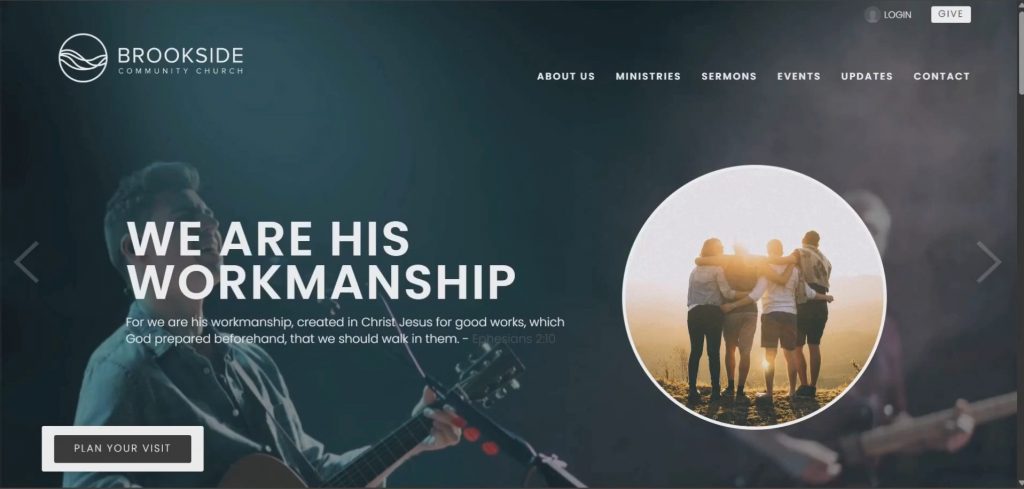How to Serve New Visitors and Current Members with One Purposeful Platform
Your church’s website isn’t just a digital bulletin board. And it’s more than an online welcome mat. It’s the intersection where your mission meets two essential audiences: new visitors looking for connection and faithful members needing clarity and tools to stay engaged.
That means your website needs to do two things well:
-
Welcome and guide new guests.
-
Serve and support your church family.
In this chapter, we’ll walk through how to build a church website that helps people plan their first visit and continue their discipleship journey once they call your church home. With simplicity, purpose, and clear next steps, your site can become a trusted, time-saving tool that fuels growth and connection.
“Do not neglect to do good and to share what you have, for such sacrifices are pleasing to God.”
—Hebrews 13:16 (ESV)
Your website is a way to share what matters. Let’s build it to serve your people and your purpose.
Why Your Website Must Serve Two Audiences
The biggest mistake churches make with their websites? They design it for only one group.
Some focus only on visitors, hoping to attract new families. Others load the homepage with insider updates and announcements that only make sense to long-time members.
But the most effective church websites do both.
Your first-time visitors are wondering:
-
When and where do you meet?
-
What will it be like?
-
Will I feel welcome?
-
Is there something for my kids?
Your current members are wondering:
-
What’s happening this week?
-
How do I give online?
-
How do I join a group or serve?
-
Where do I get resources for my family?
If your site ignores either group, it creates friction. If it serves both with clarity, it builds momentum.
Website Must-Haves for New Visitors
This is where most websites should start. Every guest wants to know: Will I fit here? Will it be worth showing up? Will I be safe and seen?
Here are the essentials:
1. Service Times and Location
Put this at the top of the homepage. Make it unmistakably clear.
-
Include physical address with Google Maps link
-
Add service times and a brief welcome message
-
Optional: include parking info or a “What to Expect” video
2. Plan Your Visit Page
A dedicated page for guests to preview what it’s like.
-
What to wear
-
Length of service
-
Kids ministry info
-
Where to go when you arrive
-
Optional form to let you know they’re coming (not required!)
“Contribute to the needs of the saints and seek to show hospitality.”
—Romans 12:13 (ESV)
Hospitality starts online. Show people they matter before they ever step inside.
3. Sermon Archive
Let people get a feel for your teaching and tone.
-
Include video or audio options
-
Keep it up-to-date with current series
-
Write short summaries for each message
Website Must-Haves for Current Members
Your existing church family needs simple ways to stay engaged, grow, and serve. A strong digital hub helps them feel connected without having to search or ask.
1. Giving Page
-
Easy-to-use giving platform
-
Clear options for recurring giving
-
Include “Why We Give” message
-
Share impact stories when possible
“Each one must give as he has decided in his heart, not reluctantly or under compulsion, for God loves a cheerful giver.”
—2 Corinthians 9:7 (ESV)
2. Small Groups or Ministries Page
-
List active groups or classes
-
Include sign-up links
-
Optional: member login to manage group participation or access materials
3. Events Calendar
-
Feature key upcoming events on homepage
-
Full calendar on a dedicated page
-
Allow online registration when needed
4. Member Resources
-
Volunteer schedules or team logins
-
Prayer request form
-
Downloadable materials (e.g. devotionals, study guides)
-
FAQ section for common questions
5. Member Login Area
If you use a church management system (ChMS), provide a link or integration where members can:
-
Update their info
-
Manage giving
-
Register for events
-
Communicate with groups
Structuring the Homepage for Two Audiences
Your homepage must be simple but smart. Think of it like a church lobby: it welcomes newcomers and directs members to what they need.
A Homepage Framework That Works:
-
Hero Area
-
Welcome message
-
Service times and location
-
Big call to action: “Plan Your Visit”
-
-
Featured Next Step
-
For example: “Join a Small Group” or “Serve This Season”
-
-
This Week at [Your Church]
-
Link to bulletin or calendar
-
Upcoming events
-
-
Watch a Message
-
Embedded latest sermon
-
-
Give Online
-
Short description and button
-
-
I’m New / I’m a Member Navigation
-
Two clear paths for users to follow
-
-
Footer
-
Contact info
-
Social links
-
Login button (if applicable)
-
Writing for Both Audiences
Your site should sound like your church: friendly, faith-filled, and personal.
-
For guests: Use warm, invitational language.
-
“We can’t wait to meet you!”
-
“Here’s what to expect.”
-
-
For members: Be clear and concise.
-
“View this week’s small group schedule.”
-
“Give securely online.”
-
Avoid jargon and acronyms. Write for someone who’s new to church, even in member areas. Clarity helps everyone.
“Let your speech always be gracious, seasoned with salt, so that you may know how you ought to answer each person.”
—Colossians 4:6 (ESV)
Keep Your Website Up to Date (Without Going Crazy)
The best church websites are updated regularly, but they don’t try to do everything.
Set a rhythm:
-
Weekly: Update homepage events, sermon media
-
Monthly: Check calendar and group info
-
Quarterly: Review ministry pages and staff contacts
-
Yearly: Refresh photos and major messaging
Assign ownership to someone who understands both the tech and the mission. If you don’t have a communications staff member, delegate this to a capable volunteer with clear guidelines.
Tools That Make This Easier
Look for website platforms built for churches like ChurchSpring. Some offer features for both guest engagement and member systems:
Whatever tool you choose, prioritize:
-
Mobile responsiveness
-
Easy editing (drag-and-drop is great)
-
Good support
-
Affordable pricing
Your Next Step: Map Your User Experience
Take 15 minutes and map the journey of a new visitor and a current member on your site. Ask:
-
Can a guest quickly plan a visit?
-
Can a member easily find what they need?
-
Are we guiding people to the right next steps?
Then choose one area to improve this week.
Final Thoughts
Your church website doesn’t have to be flashy or expensive. But it does need to serve your people.
A clear, welcoming, regularly updated site tells your community: We’re here. We care. And we’re ready to help you take the next step.
When you design with both guests and members in mind, your website becomes more than a project—it becomes a pathway for connection, growth, and Gospel impact.
“So, whether you eat or drink, or whatever you do, do all to the glory of God.”
—1 Corinthians 10:31 (ESV)
FAQs
What’s the #1 thing every church website should include?
Every church website should have clear service times and location—right at the top of the homepage. Visitors should know when and where you meet within five seconds of landing on your site.
How can our website serve both visitors and members without being cluttered?
Structure your homepage like a church lobby: one path for guests (Plan Your Visit, What to Expect) and one path for members (Groups, Giving, Events). Keep navigation simple and direct.
How often should we update our website?
The frequency of your website updates will depend on the content. For example:
- Weekly: update sermons and event info.
- Monthly: check your calendar and group details.
- Quarterly: review ministry pages and staff contacts.
- Yearly: refresh photos and major messaging.
- Consistency builds trust and avoids confusion.
We’re a small church with no communications staff. Can we still manage a good website?
Yes! Start simple with a church-focused platform like ChurchSpring that’s built for ease of use. Assign one capable volunteer to update weekly basics (events, sermons, homepage info). You don’t need a media team—you need a system.
What’s the best way to make guests feel welcome online?
Create a dedicated “Plan Your Visit” page. Include service details, kids ministry info, what to expect, and optional RSVP. Use warm, invitational language (“We can’t wait to meet you!”) to lower barriers and help them feel at ease before they arrive.
This blog is an adaptation of Chapter 5 from ChurchSpring Co-Founder Rohn Gibson’s new book Church Tech Made Simple, coming 2026.
Related Blogs:
The Mission Comes First with Church Tech








